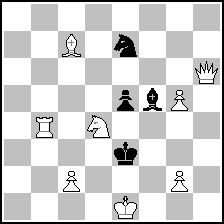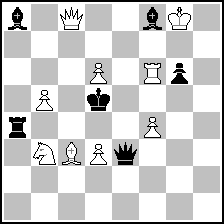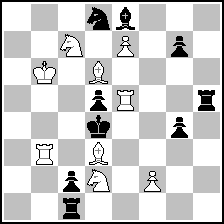|
| Page: [Previous] [Next] 1 2 |
| (1) Posted by Sarah Hornecker [Thursday, May 10, 2007 13:23] |
Hardest twomover ever? Pulitzer 1907 (#2)
Dear chess friends.
In a very interesting book of Christian Hesse ("Expeditionen in die Schachwelt") I found this twomover. Wilhelm Steinitz couldn't solve it in fifteen minutes and if you can, it is very respectable.
 (= 8+4 ) (= 8+4 )
Pulitzer, 1907
Mate in 2
Computers can find the key in much less than a second but (in a sense of emotions) they can't solve it, nor the most simple twomover!
So have fun, but please don't post the solution. Leave it as a challenge for other readers, please.
(On a personal note: Sorry for "spamming" the forum with so many topics!)
|
|
| (2) Posted by Branislav Djurašević [Thursday, May 10, 2007 14:21] |
It is not hard to solve this problem at all. I need a few minutes, maybe less, to solve it.
|
|
| (3) Posted by Miodrag Mladenović [Thursday, May 10, 2007 15:33] |
I solved it within one minute. Not so hard at all. But I guess it's very hard to estimate if twomover is hard to solve or not.
|
|
| (4) Posted by Frank Richter [Thursday, May 10, 2007 16:08] |
Well, a nice problem, but not really difficult.
Here I present the most difficult twomover from the last German Solving Championship in Wiesloch (only 10 of 28 participants found the key):
 (= 8+10 ) (= 8+10 )
#2
Good luck!
|
|
| (5) Posted by Sarah Hornecker [Thursday, May 10, 2007 16:41]; edited by Sarah Hornecker [07-05-10] |
Ok, so you're all better than Steinitz and my source was just wrong about it. :-)
PS: I think I got your key (after 3 minutes). I'll send a note.
PPS: I was wrong but it looked good. I'll try later. :-(
|
|
| (6) Posted by [Thursday, May 10, 2007 18:40]; edited by [07-05-10] |
Well, of course not. Steinitz died in 1900. (Or wasn't the
problem published until long after it had been composed?)
Later: It seems to have been published in Chess Player's Scrap
Book in April 1907, along with a quote from Steinitz as to
the difficulty as mentioned.
|
|
| (7) Posted by Zalmen Kornin [Thursday, May 10, 2007 19:49] |
|
|
| (8) Posted by Hauke Reddmann [Friday, May 11, 2007 11:19] |
<now what's that funny smell>
Meh. Solved both in less than a minute, I'm the greatest :-)
</now what's that funny smell>
Hauke
P.S. If the question can be posed in a "scientific" manner at all,
you have to split the solver set at least into
a) computers :-)
b) players
c) composers.
I know enough problems that I solved in a fraction of a second
because I begin with the most "problem-like" key first.
|
|
| (9) Posted by Zalmen Kornin [Saturday, May 12, 2007 12:00] |
:) We're still able to tell true stories from times before the computers - strange, but in the early seventies, Chess playing, composing or solving was, in some features, nearer to the 1800s then to the 2000s with the softwares, the net, databases, etc... HR said "I know enough problems that I solved in a fraction of a second
because I begin with the most "problem-like" key first."
This remind me of a little story that was also an epilogue and my revenge over that 'common solvers':
Another day I came with an earlier version of http://www.softdecc.com/pdb/comment1.pdb?P=P1067807&expression=A%3D%27Kornin%27&start=0&langt=EN&langn=EN This time, the 'common solvers' became baffled for some minutes, until that someone arrived - was Francisco Pompeo, the Club's President, and my usual mate at blitz: He guessed, in a glance, what was going on in that table: "A Problem? Mate in Two? WHOSE is this -ZK's? - So the key is..." and he made the right move at once! - it was really the most unlikelly one for ordinary players, with concepts usually strange to the OTB situations
|
|
| (10) Posted by Hauke Reddmann [Saturday, May 12, 2007 16:57] |
Yup, your problem falls *exactly* into the mentioned category.
I needed about half a minute to enter it into the computer, but
even if we neglect that time - in the time you need to "pull the trigger"
of your mouse to hit the "Solve" button...I already found the key :-)
Of course, you can play a prank on "expert solvers"; I dimly remember
a problem by Ellerman with lots of "modern" content, but it all was a
chimera and the solution a stupid check.
(Schach #13691, 11/1996)
 (= 8+10 ) (= 8+10 )
My problems are usually not very hard because I do my best to compose in a
style that doesn't obscure the theme. This might be my best offer.
Hauke
|
|
| (11) Posted by Zalmen Kornin [Saturday, May 12, 2007 22:33] |
It seems to be very tricky with those crossed batteries and the mirrored bK situation, I'll solve with pleasure - quote "I do my best to compose in a
style that doesn't obscure the theme." Right, that's the point, but if within a perfect balance, also difficulty arise, I'll not refuse (Those above are somewhat triffling, 'pièces d'occasion', but I exercised also in the Pseudo-Le-Grand manner, and ate my letters'-soup too...
|
|
| (12) Posted by David Knezevic [Monday, May 14, 2007 03:07] |
A good solver solves the kind of twomovers shown so far in this thread in a few seconds.
From my experience, the most time-consuming twomovers are those with several equally promising possibilities where the intuition cannot help. Even if you try the key move first, you can be sure that you didn't miss some hidden black defence only after you find the refutations of all remaining prominent white moves. For instance, I remember that in one competition I wasted several minutes to solve the problem quoted below despite the fact that as soon as I glanced at the diagram I remembered it. Moreover, I rememberd where I had seen it and (even more!) who was the author!
Vojko Bartolović
1.Pr Die Schwalbe 1964
 (= 9+6 ) (= 9+6 )
#2
You can test yourself...
|
|
| (13) Posted by Paz Einat [Monday, May 14, 2007 09:16] |
The near block is somewhat misleading, but after analysis of the position, and realizing it cannot be a block, the key is becoming rather obvious.
|
|
| (14) Posted by Hauke Reddmann [Monday, May 14, 2007 11:03] |
Also only half a minute...Hardest for me are the "letter" problems
with no other theme at all. Unluckily, since the arrival of the
computer noone ever sends in wrong solutions to the journals,
which might be an objective proxy for the difficulty of a problem.
In this measure, Touw Hian Bwee's 1.Bf2! in the SCHWALBE long long
ago is the hardest I know of.
Hauke
|
|
| (15) Posted by Juraj Lörinc [Tuesday, May 15, 2007 20:51] |
I concur to the Milan Velimirovic's opinion. In my view the most difficult for solving are twomovers where there are at least 4 similar keys with well hiden weaknesses of the tries. At solving competition I have sometimes had good luck and found the key as the first, sometimes I have bad luck and spend too much time on solving that little mystery. You can try a few problems from my blog (it is in Slovak, but diagrams speak for themselves):
No. 81 in http://lorinc.blog.sme.sk/c/87713/Grim-kto.html
No. 75 in http://lorinc.blog.sme.sk/c/83853/S-vezami-je-kriz.html
No. 55 in http://lorinc.blog.sme.sk/c/58242/Pokusy-oblubene-aj-nenavidene.html
No. 7 in http://lorinc.blog.sme.sk/c/11537/Riesitelia-v-Bratislave-II.html
|
|
| (16) Posted by Administrator [Sunday, Jul 5, 2009 01:22] |
Aleksandar Gulyaev
Shakhmaty v SSSR 1948
 (= 9+9 ) (= 9+9 )
#2
Judging by the "Test of the Day" results, the analysis of this problem can bring us closer to the conclusion what makes a two-move problem hard for solving. Except Mikalai Sihnevich everybody else who tried it got it wrong!
By the way, this was the fifth problem in test number - check it out! - 666 :-)
|
|
| (17) Posted by Sarah Hornecker [Sunday, Jul 5, 2009 01:47]; edited by Sarah Hornecker [09-07-05] |
On an off-topic sidenote, AP Gulyaev, known as AP Grin after 1958, was married to Olga Aleksandrovna (not OA Romanova, of course) who was born on 18th November 1908 and died on 18th February 1998.
He can never have missed any of her birthdays since AP Gulyaev (who also died on 18th February 1998) was born on - you guessed it - 18th November 1908.
More information is still sought about his wife and - of course - Gulyaev himself.
according to EG 129, p.167:
QUOTE
The Shakhmatnaya kompozitsia piece records as a footnote that his Bolshoi Theatre ballerina wife Olga Aleksandrovna was born on the same day as her husband - and died on the same day that he died.
Roycroft notes there that a lot of samizdat material about APG and his family was published. Has anyone collected it for a book yet?
See http://www.gadycosteff.com/eg/eg129.pdf#page=40 for the obituary.
See http://de.wikipedia.org/wiki/Datei:GulyaevAlexander.jpg for a photo of Gulyaev from 1985 (archive FS Bondarenko)
|
|
| (18) Posted by Dejan Glisić [Sunday, Jul 5, 2009 07:28] |
Pulitzer? I believe - Walter Pulitzer?
|
|
| (19) Posted by [Sunday, Jul 5, 2009 13:34]; edited by [09-07-05] |
Sigfried Hornecker writes:
>On an off-topic sidenote, AP Gulyaev, known as AP Grin after 1958,
Not 100% certain of that -- A Grin seems to be fairly well attested, but I'm not quite as sure about A P Grin. It could be a confusion between the two by people who knew about the pseudonym. The P is not mentioned by either Gaige or Zelepukin (as far as I can make out, at least), and I have not seen the P in any of the FIDE Albums I have, though my collection is not at all complete. The matter is not very clear: Gaige has 'Guliaev né Grin', so he seem to have believed it was a change of name, and Lommer has 'Grin alias Gulyaev', suggesting that Gulyaev was the pseudonym.
'Grin' was something Gulyaev seems to have reserved for his chess-related activities -- he appears to have been quite well-known in his own field of metallurgy, and there's no mention in the article (see below) of a change of name in his professional or private life.
>was married to Olga Aleksandrovna (not OA Romanova, of course)
O. A. Barysheva-Sharpant'e, according to an article in Metal Science and Heat Treatment, Vol. 40, Nos. 11-12. 1998, p. 433-438. (I see the centenary of his birth occasioned another article in the same periodical in 2008, but I haven't read it.)
[Added: I now see that the article cited is written by A. A. Gulyaev -- a son perhaps?]
>More information is still sought about his wife and - of course - Gulyaev himself.
Harrie Grondijs publications are difficult to come by, but I think he may has written on the topic. At least, there's the 'Grin and the critical move' from 1991. I believe he met Gulyaev when G. visited the Netherlands in the same year.
|
|
| (20) Posted by Sarah Hornecker [Sunday, Jul 5, 2009 18:37]; edited by Sarah Hornecker [09-07-05] |
Knowing this, it was not hard to find A. P. Gulyaev: Stages of life and scientific activity by AA Gulyaev. But sadly, the capitalists of commerce.metapress.com want 34 USD (!) for that article.
https://commerce.metapress.com/content/x03h3694671h7844/resource-secured/?target=fulltext.pdf
I'm interested if someone could send me the PDF file or a scan.
|
|
Read more... |
Page: [Previous] [Next] 1 2
MatPlus.Net  Forum Forum  Twomovers Twomovers  Hardest twomover ever? Pulitzer 1907 (#2) Hardest twomover ever? Pulitzer 1907 (#2) |
 ISC 2024
ISC 2024 Forum
Forum  Twomovers
Twomovers  Hardest twomover ever? Pulitzer 1907 (#2)
Hardest twomover ever? Pulitzer 1907 (#2) 


